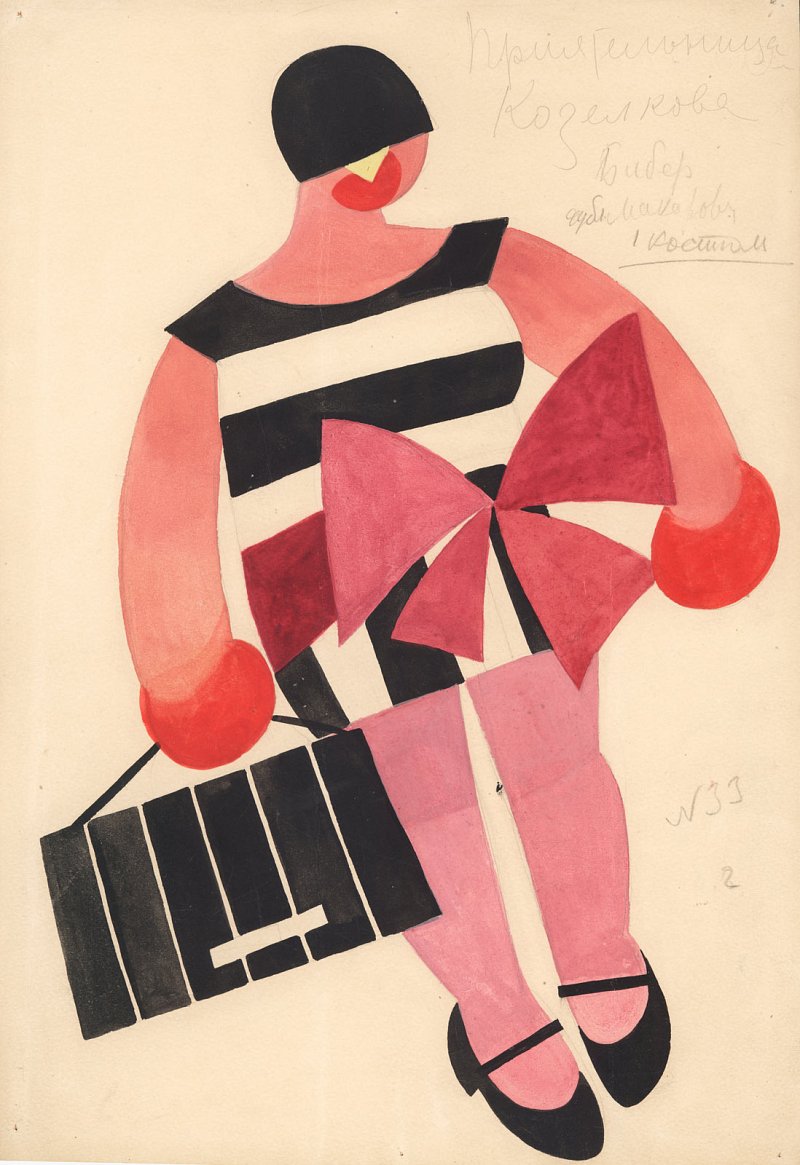
Tatiana Bruni, Kozelkov’s Girlfriend, Costume Design for ‘The Bolt,’ 1931, gouache and watercolour on paper. Courtesy GRAD and St Petersburg State Museum of Theatre and Music.
http://www.grad-london.com/whatson/
BOLT
Curated by ELENA SUDAKOVA, ALEXANDRA CHIRIAC and ELENA GRUSHVITSKAYA
Exhibition design by CALUM STORRIE and KATYA SIVERS
The Bolt, written in 1931, was probably the last Constructivist ballet, closing an era of unparalleled innovation in Soviet dance and performance. Bold designs by Tatiana Bruni and Georgii Korshikov, experimental choreography by Fedor Lopukhov, a gripping story of industrial sabotage written by Victor Smirnov and a vivid musical score by Dmitri Shostakovich made this extraordinary production a threat to the Soviet authorities. Its first ever performance at the Leningrad Academic Theatre of Opera and Ballet in April 1931 met with a violent backlash from critics and The Bolt was promptly pulled off the programme. It was 74 years before it saw the stage again, reconstructed by the Bolshoi Ballet. The exhibition brings the neglected story of this tumultuous production to life through a selection of costume designs, period photographs and original costumes.
The ballet tells of the exploits of Lenka Gulba (‘Lazy Idler’ in Russian), an indolent worker who persuades Goshka, a gullible young boy, to sabotage the production of the local factory by throwing a bolt into a machine. A typical cast of Soviet protagonists and antagonists populates ‘The Bolt’, from the upstanding Komsomol members to the villainous hooligans led by Lenka to the factory clerk Kozelkov, a wannabe city slicker. In this industrial production, which featured machine-inspired choreography, Shostakovich embellished the story with aerobics and acrobatics, with several passages mimicking the swishing and hammering sounds of modern factory machinery.
GRAD’s display feature the witty and grotesque costume designs by Tatiana Bruni bringing to life the characters that populate the ballet: from the Textile-Worker and the Typist, to the Drunkard, the Job-Hopper and the pompous Bureaucrat. Featuring striking geometrical colour blocking, Bruni’s designs were inspired by the aesthetics of agit-theatre and ROSTA windows or artist-designed propaganda posters. Shostakovich’s mischievous blend of proletarian and vaudeville music genres play through the gallery space, catapulting the viewer to early 1930s Russia and evoking Fedor Lopukhov’s daring choreography. Constructivist values and aesthetics are reflected in all of the elements of the ballet, from the costume designs to the score, choreography to set design.
That The Bolt was produced in 1931 is significant. Visual art and literature were on the cusp of monumental change in Soviet Russia, after a series of political and artistic revolutions had changed the course of modernist art and modern history. The critical rejection of the ballet can be understood within the context of a progression toward Socialist Realism, and the suppression of the vanguard imagination, accelerated by the 1932 issue of the ‘Decree on the Reconstruction of Literary and Artistic Organisations’, a measure designed to curtail artistic independence. The satirical characters and acid comedy of The Bolt stand as a bastion of an experimental spirit, which demonstrated an extraordinary edge and robustness.
The story of the ballet and its avant-garde creators can also be explored through a specially created iPad application, which features in-depth commentary from experts, clips from ballet performances and vivid illustrations. Imagined as a companion to the exhibition, this interactive guide can also be enjoyed independently, bringing The Bolt to life in captivating and colorful fashion.Currently available via the app store, the information is also available for non Apple devices to view at http://bolt.grad-london.com/.